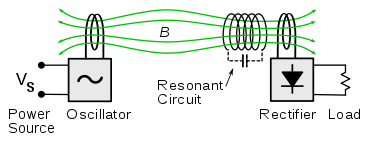
Back خاصية الرنين الكهربائية Arabic Acoblament inductiu ressonant Catalan Acoplamiento inductivo resonante Spanish تزویج القایی تشدیدی Persian 磁界調相結合 Japanese 자기 공진 결합 Korean Резонансный трансформатор Russian 諧振感應耦合 Chinese
This article may be unbalanced toward certain viewpoints. (February 2022) |
This article may relate to a different subject or has undue weight on an aspect of the subject. (February 2022) |


Resonant inductive coupling or magnetic phase synchronous coupling[4][5] is a phenomenon with inductive coupling in which the coupling becomes stronger when the "secondary" (load-bearing) side of the loosely coupled coil resonates.[5] A resonant transformer of this type is often used in analog circuitry as a bandpass filter. Resonant inductive coupling is also used in wireless power systems for portable computers, phones, and vehicles.
- ^ resonant structure in only the secondary side
- ^ High efficiency is realized by using the secondary side resonance technology. Techno Frontier 2017 OMRON AMUSEMENT Japan
- ^ Sagolsem Kripachariya Singh; T. S. Hasarmani; R. M. Holmukhe (April 2012). "Wireless Transmission of Electrical Power Overview of Recent Research & Development" (PDF). International Journal of Computer and Electrical Engineering. 4 (2): 208. ISSN 1793-8163.
- ^ Theory and verification of a model of wireless power transfer having a resonant structure in only the secondary side. IEICE Technical Report WPT2014-89 (in Japanese). Vol. 114. The Institute of Electronics Information and Communication Engineers. 13 February 2015. pp. 7–12. ISSN 2432-6380.
- ^ a b "Breakthrough was finally found in the wireless power transfer - Improve efficiency and robustness by slightly modifying the problem of magnetic resonance theory". Green Electronics (in Japanese) (19). CQ publishing: 52–69. October 2017. ISBN 9784789848503.